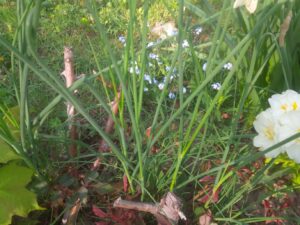 Onion grass is rearing its slender, onion-scented head right now, heralding the longer days and warmer temperatures of spring. It is one of the seasonal scourges of lawn-proud suburbanites, not to mention dedicated gardeners.
Onion grass is rearing its slender, onion-scented head right now, heralding the longer days and warmer temperatures of spring. It is one of the seasonal scourges of lawn-proud suburbanites, not to mention dedicated gardeners.
If you saw a clump of onion grass that had been dug up and cleaned, you might mistake it for a handful of undernourished scallions. Most sources suggest that the bulbs and greens are edible, though nobody I know has tried this. As members of the large allium family, onion grass is kin to common edible onions, scallions, leeks and other savory species. Dairy cows definitely eat onion grass, which, back in the days before homogenization and ultra pasteurization, made some milk products taste a little oniony in the spring.
In the lawn, onion grass, or Allium vineale, is unmistakable. Ranging in size from a single grass-like blade to clumps larger in diameter than a basketball, onion grass grows about ten times faster than common lawn grass. The stems are hollow and tend to curl at the tops. If broken, they smell very oniony with a garlicky overtone. In my lawn when the grass is two inches high, the onion grass is ten inches higher. It cannot be missed. You can mow it and the blades will fall to earth, but it will rebound with the ferocity of a Komodo dragon. By next day it will be back to taunt you and a week later the clump will be even bigger.
In garden beds onion grass can be deceptive. If you don’t look too closely, the leaves look a bit like grape hyacinth foliage. I generally sniff before I dig, preventing me from losing desirable plants as I make my annual attempts to eradicate the onion grass.
Allium vineale has made itself at home in North America, but it didn’t originate here. It grows wild in parts of Europe, the Middle East and northern Africa. I don’t know how pervasive it is in its native regions, but it caught on like wildfire in the wide open spaces of this continent. One cultivated variety, called ‘Hair’, is even sold as an ormanental. Evidently some people put it in their gardens deliberately.
So how do you cope with everyday invasive onion grass? If you have an extremely dull social life and a small to medium infestation, you can hand-dig the clumps. If you do so, beware–missing even a few of the small bulblets, will result in the onion grass roaring back, either in the late fall or next spring. There are, of course, chemical fixes, some of which will do the job nicely. Round-Up® or glycophosphate is probably the most environmentally friendly of them, but even that must be handled carefully. Like all non-selective herbicides, it may kill nearby plants that you want to keep as well as the plants that you want to get rid of.
I like to avoid herbicides and try to find a middle ground between devoting my life to onion grass eradication and letting the clumps get completely out of hand. I use my trusty large garden fork to dig every clump that I see in the flower beds. The lawn clumps, which are far larger, are removed whenever I am in the yard and have a few spare minutes. I am careful to dig out all of the bulbs and bulblets, because I cling to the romantic notion that my efforts at least keep me even with the rampaging wild allium.
If I am in the right frame of mind, I sometimes find onion grass eradication curiously relaxing. Like all other mindless, repetitive activities, it has its own rhythm and cadence. It’s great for untangling mental knots and seems especially useful for writer’s block. People with other kinds of creative impulses might compose symphonies, solve math problems or plot dinner parties while digging the bulbs. The possibilities are endless.
Getting up close and personal with these weeds is also a great way to spot other trouble makers like chickweed, which can be pulled at the same time. With all that bending and pulling, I frequently discover ornamental plants that I had forgotten about and bare spots that are ready for new ornamentals.
If all of that sounds like making lemons into lemonade, it probably is. In spring, all things are possible. It is another story completely in the fall, when onion grass reappears after a spell of summer dormancy. In September and October each clump looks like the work of the Devil and makes me pray for the hard freeze that will put an end to that particular trouble. At those times I try not to think of the fact that while my beloved daffodils are slumbering beneath the soil, the onion grass will be plotting garden domination. Some things are just too unpleasant to contemplate.
